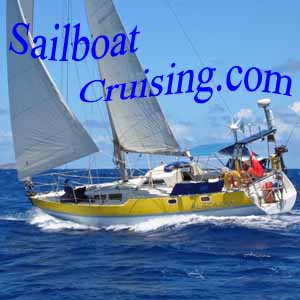- Home
- Choosing Accessories
- Parachute Sea Anchor
- Sailboat Dodgers
Sailboat Dodgers, Sprayhoods and Doghouses
Sailboat dodgers and sprayhoods are one and the same. Americans call them dodgers and we Brits call them sprayhoods. Doghouses are rigid, permanently fixed versions of sailboat dodgers - or sprayhoods. Incidentally, what we call dodgers - the protective canvas screens along the cockpit guardwires - the Americans call weather-cloths.
Fortunately, biminis are biminis on both sides of the Atlantic, and bikinis are truly international and need no further explanation.
Clear? Good, we can move on then...
All of them, with the notable exception of the last one, serve but one purpose; to protect the cockpit occupants from the elements.
Thoughtfully designed, they can truly enhance the functionality of the cockpit and the overall appearance of the sailboat.
Sadly, particularly with dodgers, aesthetics take a backseat in many cases and the otherwise attractive profile of the sailboat is ruined.
Dodgers (US) - or Sprayhoods (UK)
 A small pramhood type sprayhood (or dodger in US)
A small pramhood type sprayhood (or dodger in US)The primary function of a dodger is to avoid having to close the main hatch in inclement conditions.
And, whilst a pramhood type like the one shown here will satisfy this requirement admirably, a more substantial version will contribute greatly to cockpit comfort when the spray starts to fly.
But often the comfort aspect is allowed to take undue precedence over the following:
- Restrictions to visibility;
- Aesthetics.
Low Profile or High Profile Sailboat Dodgers?
Low Profile Dodgers
 An attractive low profile sprayhood
An attractive low profile sprayhoodA low profile dodger that you can see over when standing in the cockpit, and provides space for a crew member to huddle under it, is a good compromise.
This type can be easily and quickly folded forward out of the way when not needed.
High Profile Dodgers
 A high-profile sprayhood - effective, but not pretty
A high-profile sprayhood - effective, but not prettyHigh profile sailboat dodgers provide the greatest protection, but are often the least successful in terms of the four bullet points above. With this type, you look through its clear plastic screen when standing in the cockpit.
What you don't want is the top of the dodger to be at eye level, requiring you to stoop to see under it or stand on tiptoe to peek over it.
Stainless steel grabrails built into the framework provide additional security when going forward, but prevent the sprayhood from being fully collapsible.
At anchor in hot weather, and particularly in the tropics, the cooling breeze that might otherwise be enjoyed by cockpit occupants is neatly deflected off them by a fixed dodger.
Not so much of a problem with a smaller low profile type, but enough of one for larger versions to need zipped, roll-up windows. These are fine when new, but over a period of time salt and ultra-violet degradation will affect their operation.
Cockpit Dodgers (UK) or Weathercloths (US)
 Pockets sewn into Alacazam's cockpit dodgers (weather cloths) are very useful for stowage
Pockets sewn into Alacazam's cockpit dodgers (weather cloths) are very useful for stowageThese contribute greatly to the sense of cockpit security and reduce the likelihood of a surprise dousing in sloppy weather.
They're also a great place to append your sailboat name, and provide some privacy when you're doing something in the cockpit you'd prefer not to share with others in the anchorage.
We've stitched pockets on the inside of ours to take winch handles, rope tails, sail ties, fishing gear and all sorts of other bits and pieces.
Doghouses
 A fixed doghouse on this Amel 'Super Marimu'
A fixed doghouse on this Amel 'Super Marimu'These are the ultimate development of sailboat dodgers. Rigid and robustly constructed, they provide full protection in heavy weather and with opening windows that don't leak, they are an eminently seaworthy feature.
The windows should be of toughened or laminated glass, not acrylic or polycarbonate which will eventually craze or (in the case of polycarbonate) fog. Often smoked glass is used, which although beneficial in strong sunlight, greatly reduces night-time visibility.
Some manufacturers - like the French-built Amel range shown here - go one stage farther and include the main steering position (which of course must be a wheel) within the sailboat doghouse.
Homebuilt retro-fitted fitted versions, though often of ingenious design, are not always quite so successful from an aesthetic point of view.
Recent Articles
-
Albin Ballad Sailboat: Specs, Design, & Sailing Characteristics
Jul 09, 25 05:03 PM
Explore the Albin Ballad 30: detailed specs, design, sailing characteristics, and why this Swedish classic is a popular cruiser-racer. -
The Hinckley 48 Sailboat
Jul 09, 25 02:44 PM
Sailing characteristics & performance predictions, pics, specifications, dimensions and those all-important design ratios for the Hinckley 48 sailboat... -
The Hinckley Souwester 42 Sailboat
Jul 09, 25 02:05 PM
Sailing characteristics and performance predictions, pics, specifications, dimensions and those all-important design ratios for the Hinckley Souwester 42 sailboat...

















